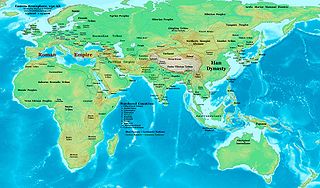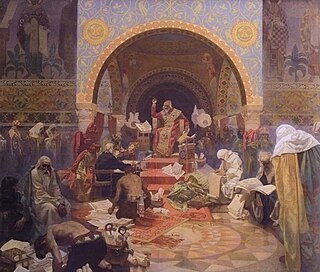
The 30s decade ran from January 1, AD 30, to December 31, AD 39.

The 40s decade ran from January 1, AD 40, to December 31, AD 49.

The 50s decade ran from January 1, 50, to December 31, 59. It was the sixth decade in the Anno Domini/Common Era, if the nine-year period from 1 AD to 9 AD is considered as a "decade".

The 70s was a decade that ran from January 1, AD 70, to December 31, AD 79.

The 80s was a decade that ran from January 1, AD 80, to December 31, AD 89.

The 100s was a decade that ran from January 1, AD 100, to December 31, AD 109.

The 120s was a decade that ran from January 1, AD 120, to December 31, AD 129.

The 1st century BC, also known as the last century BC and the last century BCE, started on the first day of 100 BC and ended on the last day of 1 BC. The AD/BC notation does not use a year zero; however, astronomical year numbering does use a zero, as well as a minus sign, so "2 BC" is equal to "year –1". 1st century AD follows.
The 0s BC is the period between 9 BC and 1 BC, the last nine years of the before Christ era. It is one of two "0-to-9" decade-like timespans that contain nine years, along with the 0s.
The 150s decade ran from January 1, 150, to December 31, 159.
The 160s decade ran from January 1, 160, to December 31, 169.
103 (CIII) was a common year starting on Sunday of the Julian calendar. At the time, it was known as the Year of the Consulship of Traianus and Maximus. The denomination 103 for this year has been used since the early medieval period, when the Anno Domini calendar era became the prevalent method in Europe for naming years.

Year 780 (DCCLXXX) was a leap year starting on Saturday of the Julian calendar, the 780th year of the Common Era (CE) and Anno Domini (AD) designations, the 780th year of the 1st millennium, the 80th year of the 8th century, and the 1st year of the 780s decade. The denomination 780 for this year has been used since the early medieval period, when the Anno Domini calendar era became the prevalent method in Europe for naming years.

Year 788 (DCCLXXXVIII) was a leap year starting on Tuesday of the Julian calendar, the 788th year of the Common Era (CE) and Anno Domini (AD) designations, the 788th year of the 1st millennium, the 88th year of the 8th century, and the 9th year of the 780s decade. The denomination 788 for this year has been used since the early medieval period, when the Anno Domini calendar era became the prevalent method in Europe for naming years.
Year 165 (CLXV) was a common year starting on Monday of the Julian calendar. At the time, it was known as the Year of the Consulship of Orfitus and Pudens. The denomination 165 for this year has been used since the early medieval period, when the Anno Domini calendar era became the prevalent method in Europe for naming years.

Year 857 (DCCCLVII) was a common year starting on Friday of the Julian calendar.
The 240s decade ran from January 1, 240, to December 31, 249.

Year 300 (CCC) was a leap year starting on Monday of the Julian calendar. At the time, it was known as the Year of the Consulship of Constantius and Valerius. The denomination 300 for this year has been used since the early Middle Ages / Medieval period, when the Latin language term / abbreviation "Anno Domini" for the calendar era became the prevalent universal / worldwide method for naming and numbering years. First beginning in Europe at the end of the Roman Empire (after the split of the Western Roman Empire and Eastern Roman Empire in the early Middle Ages / Medieval period.

Year 927 (CMXXVII) was a common year starting on Monday of the Julian calendar.
Year 4 BC was a common year starting on Tuesday or Wednesday of the Julian calendar and a common year starting on Monday of the Proleptic Julian calendar. At the time, it was known as the Year of the Consulship of Sabinus and Rufus. The denomination 4 BC for this year has been used since the early medieval period, when the Anno Domini calendar era became the prevalent method in Europe for naming years.













